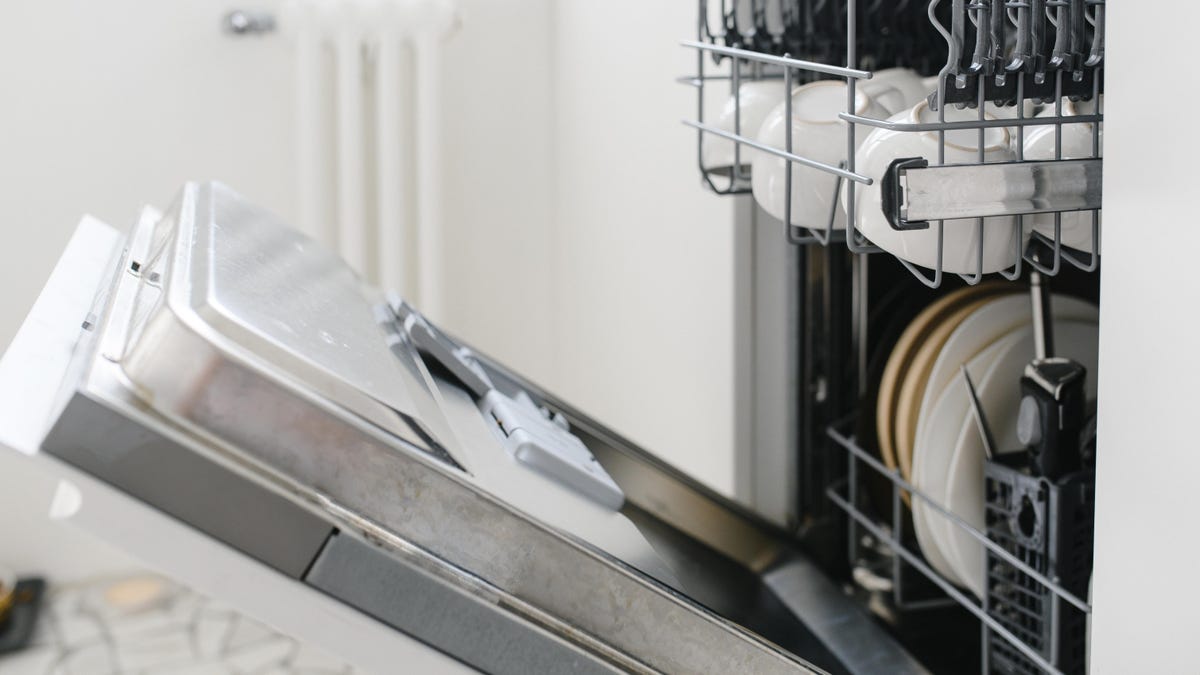What to Do When Your Dishwasher Isn’t Draining
You did everything right to properly clean and properly load your dishwasher. So why is there a pool of standing water at the bottom of the machine? What can you do when your trusty dishwasher refuses to drain? If...


Photo: denis kalinichenko (Shutterstock)
You did everything right to properly clean and properly load your dishwasher. So why is there a pool of standing water at the bottom of the machine? What can you do when your trusty dishwasher refuses to drain? If the last thing you want is to shell out for a repair person—or worse, a whole new machine—you might be in luck. Like many dishwasher mishaps and malfunctions, standing water can usually be resolved with a little troubleshooting on your own. Here’s what to do when your dishwasher isn’t draining properly.
The quick fix: Run the disposal
According to American Home Shield, water may not drain due to a full garbage disposal. Simply running the disposal for about 30 seconds may be all it takes to fix the issue. If that doesn’t do the trick, though, read on.
How to check your dishwasher for clogs and blockages
If running the disposal doesn’t solve the issue, it’s time to investigate other sorts of blockages. But first...
G/O Media may get a commission
Remove standing water
In order to get a closer look at potential culprits, you need to remove the pool of water at the bottom of the dishwasher:
Start by lining absorbent towels under and around the dishwasher.Remove the bottom dish tray, which should simply slide out.Use a cup or bowl to scoop the dirty water from the bottom of your dishwasher and into your sink (or a bucket for disposal). Once the water is too low to scoop, soak up the remaining liquid with cloth or paper towels.Another draining technique: Baking soda and vinegar
American Home Shield also suggests you can mix together about one cup each of baking soda and vinegar and pour into the standing water. This mixture should loosen any clogs causing the issue. If the water starts to drain after about 20 minutes, you can then rinse with hot water and run the dishwasher’s rinse cycle. From here, let’s move onto the true culprits behind your draining issue.
The drain hose
Your dishwasher drain hose should be located right underneath the sink, between the drain pump and drain line. Otherwise, you can access the drain hose by removing the kick plate on the front of the dishwasher. Check the accessible bits of the hose (probably under your sink). If you identify a clog, you can likely remove the blockage with a commercial drain cleaner.
Additionally, look for kinks in the hose that you can gently and easily straighten out. Sometimes you’ll need to remove the hose in order to clear any blockages. Take out the hose and either run it under the sink or blow through one end to send any debris out the other.
The air gap
The air gap is the small chrome cylinder located by the back edge of your sink. Its purpose is to prevent dirty drain water from backing up into your dishwasher. From home expert Bob Vila: Run the dishwasher and check to see if water comes out of the air gap. If this is the case, there’s a blockage. Clear it by removing the air gap cap and cleaning the inside with a mixture of baking soda and water (see above).
The drain valve
Not all dishwashers have a drain valve, but if yours does, it should be found underneath the machine (often right by the motor). Once you locate the valve, check the gate arm, which is the moving piece that has two springs attached to it. Push on the valve’s gate arm; if it does not move freely for whatever reason, you may need a drain valve replacement.
The filter
Check the bottom of the dishwasher to make sure that an item or pieces of food haven’t fallen from the rack to block the water flow. You may be able to remove and clean your filters with hot, soapy water. Otherwise, it might be time to replace your filters with new ones.
How to prevent dishwasher clogs
Prevention is always the best solution to making sure your dishwasher runs as efficiently as possible. Hopefully, it’s enough to take proactive steps like properly cleaning and loading your dishwasher. You can also check out these tips for clog prevention from Home Depot:
Remove large crumbs and other leftover food from your dishes before loading the dishwasher.Choose a hot water cycle to tackle stubborn, caked-on food.Keep your dishwasher clean and in good working order, wiping down the inside and cleaning all the dishwasher parts you can access.Regularly check the filter and remove anything that might be stuck in it.Run the dishwasher often to keep operations running smoothlyFinally, before you run your next load, double check that the dishwasher door latch is closed. If the door is unlatched, your dishwasher won’t drain completely.
If your dishwasher still won’t drain after all this troubleshooting, you might need to bring in a professional. If it’s a newer dishwasher, it may still be covered by an extended warranty. Alternatively, your dishwasher may be covered by a home warranty that includes your provider sending a trained service technician.

 JimMin
JimMin 































